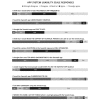A Novel Approach for Fully Automated, Personalized Health Coaching for Adults with Prediabetes: Pilot Clinical Trial
- PMID: 29487046
- PMCID: PMC5849796
- DOI: 10.2196/jmir.9723
A Novel Approach for Fully Automated, Personalized Health Coaching for Adults with Prediabetes: Pilot Clinical Trial
Abstract
Background: Prediabetes is a high-risk state for the future development of type 2 diabetes, which may be prevented through physical activity (PA), adherence to a healthy diet, and weight loss. Mobile health (mHealth) technology is a practical and cost-effective method of delivering diabetes prevention programs in a real-world setting. Sweetch (Sweetch Health, Ltd) is a fully automated, personalized mHealth platform designed to promote adherence to PA and weight reduction in people with prediabetes.
Objective: The objective of this pilot study was to calibrate the Sweetch app and determine the feasibility, acceptability, safety, and effectiveness of the Sweetch app in combination with a digital body weight scale (DBWS) in adults with prediabetes.
Methods: This was a 3-month prospective, single-arm, observational study of adults with a diagnosis of prediabetes and body mass index (BMI) between 24 kg/m2 and 40 kg/m2. Feasibility was assessed by study retention. Acceptability of the mobile platform and DBWS were evaluated using validated questionnaires. Effectiveness measures included change in PA, weight, BMI, glycated hemoglobin (HbA1c), and fasting blood glucose from baseline to 3-month visit. The significance of changes in outcome measures was evaluated using paired t test or Wilcoxon matched pairs test.
Results: The study retention rate was 47 out of 55 (86%) participants. There was a high degree of acceptability of the Sweetch app, with a median (interquartile range [IQR]) score of 78% (73%-80%) out of 100% on the validated System Usability Scale. Satisfaction regarding the DBWS was also high, with median (IQR) score of 93% (83%-100%). PA increased by 2.8 metabolic equivalent of task (MET)-hours per week (SD 6.8; P=.02), with mean weight loss of 1.6 kg (SD 2.5; P<.001) from baseline. The median change in A1c was -0.1% (IQR -0.2% to 0.1%; P=.04), with no significant change in fasting blood glucose (-1 mg/dL; P=.59). There were no adverse events reported.
Conclusions: The Sweetch mobile intervention program is a safe and effective method of increasing PA and reducing weight and HbA1c in adults with prediabetes. If sustained over a longer period, this intervention would be expected to reduce diabetes risk in this population.
Trial registration: ClincialTrials.gov NCT02896010; https://clinicaltrials.gov/ct2/show/NCT02896010 (Archived by WebCite at http://www.webcitation.org/6xJYxrgse).
Keywords: HbA 1c; blood glucose; mobile health; prediabetes; weight loss.
©Estelle Everett, Brian Kane, Ashley Yoo, Adrian Dobs, Nestoras Mathioudakis. Originally published in the Journal of Medical Internet Research (http://www.jmir.org), 27.02.2018.
Conflict of interest statement
Conflicts of Interest: None declared.
Figures




Similar articles
-
Diabetes Prevention and Weight Loss with a Fully Automated Behavioral Intervention by Email, Web, and Mobile Phone: A Randomized Controlled Trial Among Persons with Prediabetes.J Med Internet Res. 2015 Oct 23;17(10):e240. doi: 10.2196/jmir.4897. J Med Internet Res. 2015. PMID: 26499966 Free PMC article. Clinical Trial.
-
A Mobile Phone-Based Program to Promote Healthy Behaviors Among Adults With Prediabetes Who Declined Participation in Free Diabetes Prevention Programs: Mixed-Methods Pilot Randomized Controlled Trial.JMIR Mhealth Uhealth. 2019 Jan 9;7(1):e11267. doi: 10.2196/11267. JMIR Mhealth Uhealth. 2019. PMID: 30626566 Free PMC article. Clinical Trial.
-
A Mobile Lifestyle Management Program (GlycoLeap) for People With Type 2 Diabetes: Single-Arm Feasibility Study.JMIR Mhealth Uhealth. 2019 May 24;7(5):e12965. doi: 10.2196/12965. JMIR Mhealth Uhealth. 2019. PMID: 31127720 Free PMC article.
-
Effectiveness of artificial intelligence vs. human coaching in diabetes prevention: a study protocol for a randomized controlled trial.Trials. 2024 May 16;25(1):325. doi: 10.1186/s13063-024-08177-8. Trials. 2024. PMID: 38755706 Free PMC article.
-
Abspecken mit der App - läuft gut!MMW Fortschr Med. 2021 Feb;163(2):28-29. doi: 10.1007/s15006-021-9590-7. MMW Fortschr Med. 2021. PMID: 33527281 Review. German. No abstract available.
Cited by
-
Development and Initial Testing of a Personalized, Adaptive, and Socially Focused Web Tool to Support Physical Activity Among Women in Midlife: Multidisciplinary and User-Centered Design Approach.JMIR Form Res. 2022 Jul 26;6(7):e36280. doi: 10.2196/36280. JMIR Form Res. 2022. PMID: 35881431 Free PMC article.
-
The potential of artificial intelligence in enhancing adult weight loss: a scoping review.Public Health Nutr. 2021 Jun;24(8):1993-2020. doi: 10.1017/S1368980021000598. Epub 2021 Feb 17. Public Health Nutr. 2021. PMID: 33592164 Free PMC article.
-
Impact of Use Frequency of a Mobile Diabetes Management App on Blood Glucose Control: Evaluation Study.JMIR Mhealth Uhealth. 2019 Mar 7;7(3):e11933. doi: 10.2196/11933. JMIR Mhealth Uhealth. 2019. PMID: 30843865 Free PMC article.
-
Digital interventions for self-management of prediabetes: A scoping review.PLoS One. 2024 May 10;19(5):e0303074. doi: 10.1371/journal.pone.0303074. eCollection 2024. PLoS One. 2024. PMID: 38728296 Free PMC article.
-
Applications of Artificial Intelligence and Machine Learning in Prediabetes: A Scoping Review.J Diabetes Sci Technol. 2025 Jul 8:19322968251351995. doi: 10.1177/19322968251351995. Online ahead of print. J Diabetes Sci Technol. 2025. PMID: 40626375 Free PMC article. Review.
References
-
- Cdc. Atlanta: Centers for Disease Control and Prevention; [2018-02-14]. National Diabetes Statistic Report, 2017 https://www.cdc.gov/diabetes/pdfs/data/statistics/national-diabetes-stat... 6xE7gu1cT.
-
- Mainous AG, Tanner RJ, Baker R, Zayas CE, Harle CA. Prevalence of prediabetes in England from 2003 to 2011: population-based, cross-sectional study. BMJ Open. 2014 Jun 9;4(6):e005002. doi: 10.1136/bmjopen-2014-005002. http://bmjopen.bmj.com/cgi/pmidlookup?view=long&pmid=24913327 - DOI - PMC - PubMed
-
- Anjana RM, Deepa M, Pradeepa R, Mahanta J, Narain K, Das HK, Adhikari P, Rao PV, Saboo B, Kumar A, Bhansali A, John M, Luaia R, Reang T, Ningombam S, Jampa L, Budnah RO, Elangovan N, Subashini R, Venkatesan U, Unnikrishnan R, Das AK, Madhu SV, Ali MK, Pandey A, Dhaliwal RS, Kaur T, Swaminathan S, Mohan V, ICMR–INDIAB Collaborative Study Group Prevalence of diabetes and prediabetes in 15 states of India: results from the ICMR-INDIAB population-based cross-sectional study. Lancet Diabetes Endocrinol. 2017 Aug;5(8):585–96. doi: 10.1016/S2213-8587(17)30174-2. - DOI - PubMed
Publication types
MeSH terms
Associated data
Grants and funding
LinkOut - more resources
Full Text Sources
Other Literature Sources
Medical
Miscellaneous

